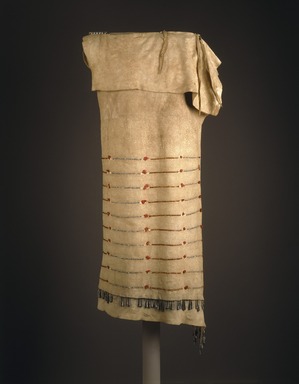
Artist:Yankton, Nakota, Sioux
Medium: Buffalo hide(?), dyed bird and porcupine quills, copper, tinned iron and copper cones, glass pony beads, yarn, pigment, sinew
Geograhical Locations:
Dates:early 19th century
Dimensions: 50 x 16 in. (127 x 40.6 cm)
Collections:
Accession Number: 50.67.6
Image: 50.67.6_SL1.jpg,
Catalogue Description: Woman's side-fold hide dress consists of six pieces: the main body of the dress, the flounce, the shoulder flap, the top bodice, and two hide thongs as a second shoulder strap. The horizontal seam is low and the folded over portion is shorter and would barely cover the breast. The folded over flap is even shorter in the back. The hide is worked so that the flesh side of the skin lies against the wearer, with the fur side out. The flounce is laced with hide thong. The seam of the dress, the blue and white pony beads on the shoulder strap, and the hem tabs are all sewn. It is likely that the two bottom tabs at the left side of the dress are formed from a remnant of the foreleg of the animal or are a decorative form to resemble this pattern technique imitating the animal's legs. Ten quilled stripes are worked around the skirt of the dress, horizontally, in measured registers of blue (once blue-green but faded since original BMA acquisition) and brown quill, separated by shorter sections of white porcupine quill where red tufts, once the tassels, of yarn emerge. Small black lines separate each quilled section. Some vertical marks of what is probably ochre appear at the ends of the quilled bands. Tin cones and a few copper cones are sewn to the bottom of the flounce, more or less at knee length, and on the two bottom tabs, which are further elaborated with an edging of blue and white beads. Five pairs of copper cones are sewn up the side seam. If the shoulder strap is examined from above, blue and white beads can be seen ornamenting the seams. A single row or blue beads edges the sides while the front and back seams display eight bands of two rows of white beads alternating with two rows of blue pony beads. See Jarvis supplemental file in Arts of Americas office or Brooklyn Museum Library.